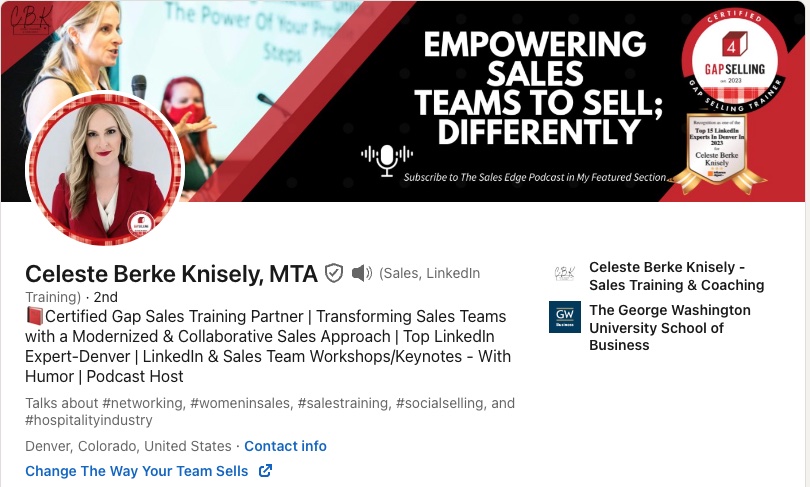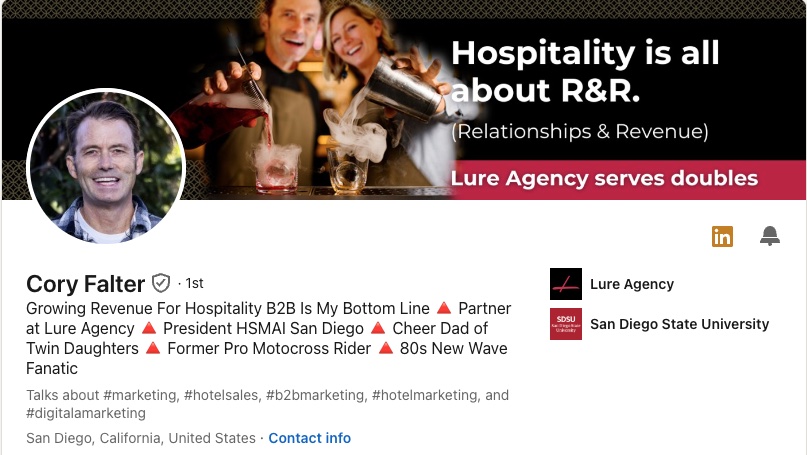
Are you ready to level up your prospecting?
Cold calling, awkward face-to-face meetings, and the endless cycle of "just checking in" emails are so last season.
The hotel sales scene is getting a much-needed makeover, transitioning from the dark ages into a new modern world of social selling.
It's sleek, savvy, and here to save us from the monotony of traditional advertising sales tactics that, frankly, no one will miss.
Leading the charge into this brave new world of lead generation is none other than Celeste Berke Knisely, a Certified Gap Sales Training Partner.
She's not just talking the talk; she's walking the walk, and she spilled all her secrets on the InnSync Show with Cory. Together, they embarked on a quest to demystify social selling for hotel sales professionals everywhere.
So, buckle up, ditch the script, and prepare to be enlightened.
In this post we'll cover:
- What is Social Selling?
- The Role of Relationships in Sales (They're Not What You Think!)
- Your LinkedIn Profile as Your Best Sales Assistant
- How to Optimize Your LinkedIn Profile for Social Sales Success
- Engaging with Your Network
- Free (No Opt-In Required) Social Selling Checklist PDF
- Common Pitfalls to Avoid
- Getting Started with Social Selling
Social Selling Success
With Celeste and Cory as your guides, you're about to embark on a journey that promises to transform cold leads into warm connections and awkward introductions into meaningful engagements.
Welcome to the future of hotel sales, where being social doesn't just mean attending industry mixers—it's the key to unlocking a whole new level of success.
What Is Social Selling?
Social selling is a modern sales technique that leverages social media platforms to build relationships, engage directly with potential clients, and enhance sales performance.
Unlike traditional sales methods, which often rely on cold calling and impersonal email blasts, the social selling strategy focuses on creating meaningful connections with prospects through social media networks like LinkedIn, Twitter, Facebook, and Instagram.
The core idea behind social selling is to use these platforms to find, connect with, engage, and nurture sales prospects through sharing valuable content, participating in industry conversations, and demonstrating expertise in a way that attracts potential customers.
By establishing a strong personal brand and becoming a trusted source of valuable information themselves, sales professionals can effectively draw prospects toward them rather than reaching out in a way that might be considered intrusive.
Celeste says, "Social selling is really about having a social presence, somewhere in the digital landscape and talking about problems you solve, value you bring, your expertise, being that almost like a mayor, you know everything you can help without attaching to any outcome being a magnet for people to come into you, so you can start building a pipeline for the present and future.”
Social selling is not about bombarding strangers with unsolicited pitches from sales reps, but rather, it is about fostering genuine relationships and connections and demonstrating value. It's a long-term strategy that requires patience, consistency, and a focus on providing value to existing customers and potential clients.
The Role of Relationships in Sales (They're Not What You Think!)
The common belief that relationships are the bedrock of a sales team is one that Celeste challenges in more sales than.
While relationships do hold importance, Celeste emphasizes the need for a shift in perspective:
"We debunk the myth that relationships matter... People buy because they identified we had a problem. We have to move the needle on understanding the problems that we solve for a meeting planner, for example, and how we can help them, how we help them better than our competition, and how we help solve a problem for them versus just leaning on that relationship-building piece.”
Cory adds, “Buyers don't necessarily need to like you, but they must trust you. It’s important to be their trusted advisor.”

Your LinkedIn Profile as Your Best Sales Assistant
Imagine a sales assistant who works tirelessly for you 24 hours a day.
That’s what LinkedIn is; it serves as the forefront of your personal brand and professional persona.
A properly optimized profile showcases your skills, achievements, and expertise to a vast audience, pre-qualifying leads and building trust before you've even exchanged a word.
Effectively communicating your value proposition and establishing your credibility opens doors to opportunities, making it an invaluable tool in your sales arsenal.

In essence, a well-optimized LinkedIn profile is not just a reflection of your professional identity; it's a dynamic sales funnel and assistant that amplifies your reach, enhances your visibility, and accelerates your sales cycle.
Celeste adds, “LinkedIn has an amazing relationship with Google, which means if someone Googles you, your LinkedIn profile is going to be in the top three search results. So, if your LinkedIn profile if it is blank, what does that say about you?”
Individual profiles are showing up higher in search results than brands - when brands are paying hundreds of thousands of dollars for a website and visibility - when individual sales professionals should be utilizing this real estate as their own personal website, and it’s free!
“If you are not positioning yourself as the expert,” Celeste says, “ you are missing out.”
Taking advantage of this digital real estate means not only filling out your profile with current positions and past experiences but also actively engaging in sharing insights, commenting on industry news, and being a part of relevant conversations. It's about transforming your profile from a static resume into a vibrant, interactive portfolio that showcases your thought leadership and industry expertise.
YOU MAY ALSO ENJOY:
- Sales Manager vs Trusted Advisor: What’s the Difference and Which is Better?
- Supercharge Your Marketing with Social Proof - Here's How!
- Linkedin is Hosting Your Biggest Networking Event
How to Optimize Your LinkedIn Profile for Social Sales Success
Transforming your LinkedIn profile into a high-octane sales assistant requires more than just ticking off the professional boxes.
As Celeste and Cory highlight, the secret sauce to social sales success lies in making your profile a magnet for prospects by focusing on them, not just on you.
Here's how to infuse your LinkedIn with the kind of charisma that attracts connections and opens up conversations:
1. Rethink Your Headline
Go beyond the generic job titles.
Cory suggests, “consider not using 'sales manager' in your title. Make it about your prospect answering the question, ‘what’s in it for me?” Craft a headline that spells out how you solve problems for your audience."
Celeste advises incorporating keywords for searchability but warns against industry jargon that might confuse your prospects. "Your headline has 220 characters of prime real estate. Use them wisely to state clearly how you help your clients," she adds.
2. Personalize Your Profile
Cory shares a personal anecdote to underscore the power of relatability, "After I posted about riding dirt bikes and motocross, I made a powerful connection with someone I barely knew over our shared interests."
Sharing personal information, for Cory, proved that personal tidbits can serve as conversation starters.

Whether you're a "proud cheer dad," a "new wave eighties fanatic," or "socially awkward," sharing personal interests can make your profile more approachable and memorable.
3. Leverage Your 'Above the Fold'
The first section of your LinkedIn profile—what's visible before someone scrolls—is your digital beachfront property.
"Make it about your prospect," Cory advises. This means your banner, profile photo, and the About section should immediately convey what value you offer to them."
It's your chance to make a compelling first impression that speaks directly to the needs and interests of your next potential customers and clients.
4. Show, Don't Just Tell
Celeste emphasizes the importance of using your profile as a dynamic platform to demonstrate your expertise and value. "If you want to drive reviews and have a selling extension of yourself while you sleep, your profile needs to work for you."
Incorporate rich media, like videos or presentations, to showcase your achievements, projects, or moments that highlight your professional journey and skills.
5. Engagement is Key
Both Celeste and Cory highlight the importance of active engagement on LinkedIn.
Your profile isn't just a static resume; it's a living, breathing extension of your professional self. Engage with your network, share insightful and valuable content, and comment on relevant posts. This boosts your visibility and establishes you as a thought leader in your space.
6. Optimization for Visibility
"LinkedIn has an amazing relationship with Google," Celeste points out, underscoring the importance of a well-optimized profile for search engine visibility. "This means carefully selecting keywords, updating your activities, and ensuring your profile is complete and engaging."
A profile that appears at the top of Google searches can significantly enhance your digital presence and lead generation efforts.
Engaging with Your Network
Engaging with your network on LinkedIn is about much more than accumulating likes or passive scrolling. Meaningful interaction, particularly commenting, is the golden key to unlocking the true potential of LinkedIn for social selling.
Celeste says, “Stop commenting on other hospitality sellers. You have to get in and start commenting on people who could be referrals or someone at a top or target account of yours.”
It’s not unlike going to a physical networking event and stepping out of your comfort zone to forge new connections.
Cory adds, "You need to break your Like button; commenting is the most effective way to build a rapport that will build offline conversations.”
Transforming your LinkedIn activity from passive to active engagement—focusing on how you can help others rather than just promoting yourself—can significantly amplify your reach, establish your expertise, and build the kind of trust that leads to fruitful professional relationships.

Common Pitfalls to Avoid
Social selling, while a powerful tool in the digital sales arsenal, is not without its challenges and common pitfalls.
Navigating the landscape of social selling requires awareness and strategy to avoid these common mistakes:
1. Lack of a Consistent Strategy
Jumping into the social selling space without a clear plan or consistent approach can lead to sporadic efforts with little to no impact. Success in a social selling platform comes from regular engagement, consistent content sharing, and a coherent message across your brand's various social selling and media channels and networks.
2. Over-Promotion
A common mistake is using social media platforms solely for self-promotion without adding value to the audience.
Social selling is about building relationships and trust, not bombarding your network with sales pitches. The key to social selling success is to share insightful and relevant content, engage in meaningful conversations, and showcase your expertise to benefit your audience.
3. Neglecting Personal Branding
Failing to develop a strong personal brand that resonates with your professional identity and values can hinder your social selling and sales efforts. Your online and social media presence should clearly communicate who you are, what you stand for, and how you can help your prospects.
Inconsistencies or inaccuracies in your profile information, job history, or skills can damage your credibility. Ensuring that your LinkedIn and other social media profiles are up-to-date and accurately reflect your professional experience and capabilities is crucial for building trust.
4. Ignoring the Importance of Engagement
Some sales professionals underestimate the importance of engaging with their network. Liking posts is not enough; commenting, sharing insights, and initiating conversations are crucial components of effective social selling.
Engagement fosters visibility and positions you as a thought leader in your field.
5. Failing to Listen and Adapt
Not paying attention to your audience's needs, feedback, and the evolving landscape of your industry can make your social selling efforts futile.
Social selling is as much about social listening as it is about sharing; understanding your audience's challenges and preferences enables you to tailor your approach and content accordingly.
6. Inconsistent or Inaccurate Personal Information
Inconsistencies or inaccuracies in your profile information, job history, or skills can damage your credibility. Ensuring that your LinkedIn and other social media profiles are up-to-date and accurately reflect your professional experience and capabilities is crucial for building trust.
7. Underutilizing LinkedIn Features
LinkedIn offers a variety of features designed to enhance your social selling efforts, such as LinkedIn Pulse for publishing articles, LinkedIn Groups for community engagement, and Sales Navigator for advanced sales insights.
Not leveraging these tools can result in missed opportunities to connect with your target audience.
8. Impatience and Unrealistic Expectations
Social selling is a long-term strategy; expecting immediate results can lead to frustration and abandonment of the effort. Building relationships and establishing trust takes time, and success in a successful social listening and selling program and strategy is measured in months and years, not days and weeks.
9. Not Personalizing Connection Requests
Sending generic connection requests without personalization can result in a low acceptance rate. Writing a personalized message that mentions a common interest, mutual connection, or specific reason for connecting can significantly increase your success rate.
Celeste adds one more pitfall, “It's usually the self-talk, the negative self-talk. We're all at that place where someone is further along the journey than us. Someone is more successful, But you’ve still got value to add. Don’t let the negative self-talk stop you.”
Getting Started with Social Selling
For those new to the social selling tool, the journey begins with profile optimization. Celeste suggests looking at others' profiles for inspiration and gradually building your own. This foundational step sets the stage for active engagement and value-driven interactions on LinkedIn.
In wrapping up The Beginner’s Guide to Social Selling with Celeste and Cory, it's clear that the landscape of hotel sales is undergoing a revolutionary transformation. From traditional, often impersonal, sales tactics to a dynamic, relationship-driven approach that leverages the power of social media.
Social selling, as we've discovered, is far more than just a buzzword; it's a strategic approach that champions building genuine connections over making cold calls. The emphasis on nurturing relationships, engaging meaningfully on platforms like LinkedIn, and establishing oneself as a thought leader are not just tactics but essential skills for success in today's digital-first world.
Welcome to the new era of hotel sales, where the art of social engagement leads the way to thriving in the modern marketplace.




